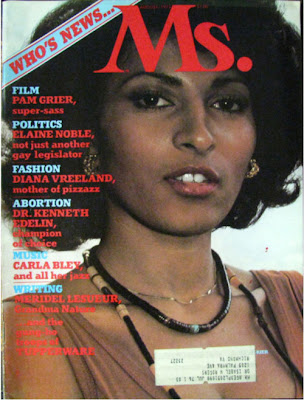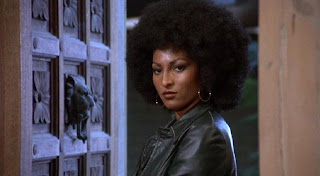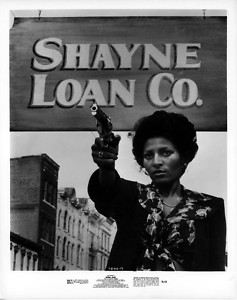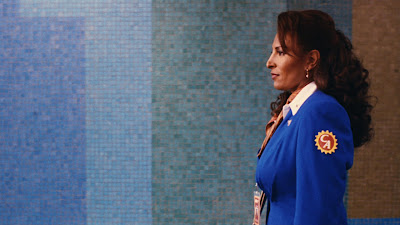 |
| Pam Grier was the first black woman to be on the cover of Ms. Magazine (August 1975). Jamaica Kincaid wrote the article, “Pam Grier: The Mocha Mogul of Hollywood.” |
This repost by Leigh Kolb appears as part of our theme week on The Great Actresses.
[Warning: spoilers ahead!]
The first time I saw Pam Grier in a film, I blurted out, “Why isn’t she in everything?”
I first saw Grier in
Jackie Brown, and couldn’t understand why she wasn’t featured prominently in more films (and then I quickly remembered African American female protagonists are few and far between). It wasn’t always this way, though.
Grier’s
legacy has
lasted over four decades, but there’s something about her career that leaves me feeling unsettled, as if her filmography is indicative of larger (backward) social trends. She started out headlining action films–an amazing feat for a woman, much less a Black woman in the early 1970s. A glance at a few of these films show feminist themes that are incredibly rare 40 years later. Her early films were groundbreaking, but nothing much was built after that ground was broken.
Coffy (Grier) is a nurse with a passion for bringing justice to those who keep drugs on the streets. The film opens with her posing as a seductive addict, and she gets herself in an apartment with a drug dealer and supplier. She brutally kills them, and then reports to her job as a nurse.
Coffy is a vigilante, trying to avenge those who made it possible for her 11-year-old sister to get hooked on drugs, causing her to wind up in a juvenile rehabilitation center. After her friend (a “good” cop, unlike many who are tied into the drug trade) is beaten brain dead after defending her, Coffy has an even deeper sense of purpose in retaliating against the machine that’s fostering corruption in her community.
 |
| “This is the end of your rotten life, you motherfuckin’ dope pusher!” |
While Coffy uses her sexuality to position herself against her enemies, she does what she need to do to win. When a john is degrading her, she says, “You want to spit on me and make me crawl? I’m gonna piss on your grave tomorrow.” Racism, greed, corruption and masculine shows are evil, and a capable woman undoes it all.
The overall quality of the film, the fashion, the music–it’s clearly dated. However, the strong female protagonist stands out as something that’s all too foreign in 2013.
Probably the most popular of Grier’s blaxploitation films, Foxy Brown follows its protagonist through another journey of violent revenge. Foxy sets out to seek justice for the murder of her boyfriend (a government agent who worked to get drugs off the streets–again, an anti-drug theme). She poses as a prostitute to infiltrate the drug/prostitution/sex slave network that’s responsible for the blight of her community. She outwits her enemies and captors at every turn, and ends victorious.
When she’s going to the neighborhood committee for help at the end, she pleads:
“It could be your brother too, or your sister, or your children. I want justice for all of them. And I want justice for all the people whose lives are bought and sold, so that a few big shots can climb up on their backs, and laugh at the law, and laugh at human decency. But most of all, I want justice for a man, this man had love in his heart, and he died because he went out of his neighborhood to do what he thought was right.”
The group leader responds, “Sister, I think what you’re asking for is revenge.”
She says, “You just take care of the justice, and I’ll handle the revenge by myself.”
 |
| “The party’s over, Oscar, let’s go.” |
Grier’s body–from the opening bikini-clad sequence to close-up shots of her naked breasts–is objectified more frequently in this film than Coffy. She had become more of a star at this point, and producers decided against it being a sequel to Coffy (as the writer had intended), so her career wasn’t a part of the film. Foxy is still a strong, empowered woman–she seeks help from her peers (the new “anti-slavery” society), helps other women and punishes men who are cruel to women. Foxy’s role seems as revolutionary as Coffy’s (maybe more so, with the increased star power).
The opening credits to Sheba Baby are set to Barbara Mason’s “Sheba, Baby,” boasting how Sheba Shayne is a “sensuous woman playing a man’s game,” “she’s kicking ass and taking names,” and “she’s a dangerous lady, who is well put together…” Sheba is a private investigator in Chicago (a no-nonsense businesswoman, as she yells at her partner for leaving the office a mess) who is called to her hometown of Louisville when her father is in danger. She’d been a cop in the town before leaving, and an old love interest is in business with her father, who owns a loan company. Themes of police ineffectiveness and corrupt white men at the top of a chain of violence are featured again, and Sheba takes justice into her own hands when the police only step up when it’s too late (after her father is killed). She uses her looks to gain access to a yacht party, where she struggles, fights and overcomes the men who are responsible for her father’s death (as well as shutting down many other Black-run businesses in the neighborhood).
 |
| “Now you tell your boss that he is not dealing with my father anymore. He is dealing with Sheba Shayne.” |
While the themes in this film are similar–anti-racism, anti-white patriarchal corruption and pro-vigilante justice–Sheba, Baby is unique in Sheba’s even fiercer independence than the previous films. When Brick asks her if she “has anyone” in Chicago, she replies: “If you’re asking if I sleep alone every night, I’d have to say no. If you’re asking if I’m going steady with anyone, I’d have to say no. So what are you asking?” The next shot, they are in bed together. However, Sheba doesn’t rely on Brick’s help (she works without him), and leaves him at the end of the film because their separate careers are too valuable. In the final shot of the film, she’s walking the streets of Chicago, smiling and confident.
The ending of
Sheba, Baby should have been indicative of a future of Grier’s style of female protagonist. However, Grier wouldn’t again headline a film until
Jackie Brown, Quentin Tarantino’s 1997 film (he wrote it specifically for Grier, and she was nominated for numerous awards for it, including a Golden Globe). She certainly worked in the interim, and has since (including stage work and starring in
The L Word). But nothing like the string of films she starred in in the 1970s.
When asked about being the first woman to play this type of powerful character, Grier
responded:
“I saw women share the platform with men in my personal world, and Hollywood just hadn’t wakened to it yet. Bette Davis and Katharine Hepburn changed the way they saw women during the 1940s, but I saw it daily in the women’s movement that was emerging, because I was a child of the women’s movement. Everything I had learned was from my mother and my grandmother, who both had a very pioneering spirit. They had to, because they had to change flat tires and paint the house—because, you know, the men didn’t come home from the war or whatever else, so women had to do these things. So, out of economic necessity and the freedoms won, by the ’50s and ’60s, there was suddenly this opportunity and this invitation that was like, ‘Come out here with these men. Get out here. Show us what you got.'”
She certainly did. But like so many cultural revolutions, the women’s movement saw backlash in the 1980s and beyond, as did this new kind of feminist, African American cinematic genre.
Grier points out that she’s often criticized for the nudity and violence in her early films.
In regard to the nudity, she says,
“We’ve got $20 million actresses today who are nude in Vanilla Sky, nude in Swordfish. So what did I do different? I got paid less, but that’s it.”
To critics of the violence, she points out,
“I saw more violence in my neighborhood and in the war and on the newsreels than I did in my movies, so it didn’t bother me. Coming from the ’50s, things were very violent. We were still being lynched. If I drove down through the South with my mother, I might not make it through one state without being bullied or harassed. I feel like unless you’ve been black for a week, you don’t know. A lot of people were really up in arms about nothing, and if you challenge them, they go, ‘Well, maybe you’re right.'”
She also notes that although some people objected to the term “blaxploitation,” she didn’t feel the films were demeaning:
“You know, Clint Eastwood, Sylvester Stallone, they can all do shoot-’em-ups. Arnold Schwarzenegger can kill 10 people in one minute, and they don’t call it ‘white exploitation.’ They win awards and get into all the magazines. But if black people do it, suddenly it’s different than if a white person does it.”
Her poignant commentary on the double standards in Hollywood serves as a larger reminder of the double standards in society. The notion of a Black protagonist fighting villainous white people is something that is still
uncomfortable. Grier’s nudity in the early films, and her blatant sexiness, felt
different than typical female objectification. Even when her cleavage was featured prominently, she had the power–she wasn’t passive, so her sexuality didn’t seem like a marker of weakness simply for the male gaze. It was jarring to feel so comfortable with what looked like female objectification, because it was so different than what we are used to now. Looking at the poster art from her earlier films, one would see her portrayed as an object. However, in the actual films, she is a sexual being, with agency, independence and strength.
 |
| Jackie Brown |
The
Ms. article “In Praise of Baadasssss Supermamas” points out that “…Coffy and Foxy fought against systems that beat up on everyday folk. Imagine what they would do in the 21st century.” It’s a pretty great thought.However, it’s more likely that we get Fighting Fuck Toys (FFTs) in modern cinema, and as Caroline Heldman
writes:
“Hollywood rolls out FFTs every few years that generally don’t perform well at the box office (think Elektra, Catwoman, Sucker Punch), leading executives to wrongly conclude that women action leads aren’t bankable. In fact, the problem isn’t their sex; the problem is their portrayal as sex objects. Objects aren’t convincing protagonists. Subjects act while objects are acted upon, so reducing a woman action hero to an object, even sporadically, diminishes her ability to believably carry a storyline. The FFT might have an enviable swagger and do cool stunts, but she’s ultimately a bit of a joke.”
Grier’s heroes are never the joke, and that’s what works. She can carry a storyline, have sex when she wants it (or not) and end up victorious, with her complete agency intact. She’s a subject acting upon the injustices around her.
Pam Grier is an incredible actress, and her most iconic roles serve as a reminder that women
can do it all on the big screen. It’s just been too long since they’ve been allowed to.
—–
Leigh Kolb is a composition, literature and journalism instructor at a community college in rural Missouri.






LOVE her. great tribute piece